transmission CHEVROLET CORVETTE 1993 4.G Owners Manual
[x] Cancel search | Manufacturer: CHEVROLET, Model Year: 1993, Model line: CORVETTE, Model: CHEVROLET CORVETTE 1993 4.GPages: 370, PDF Size: 21.43 MB
Page 42 of 370
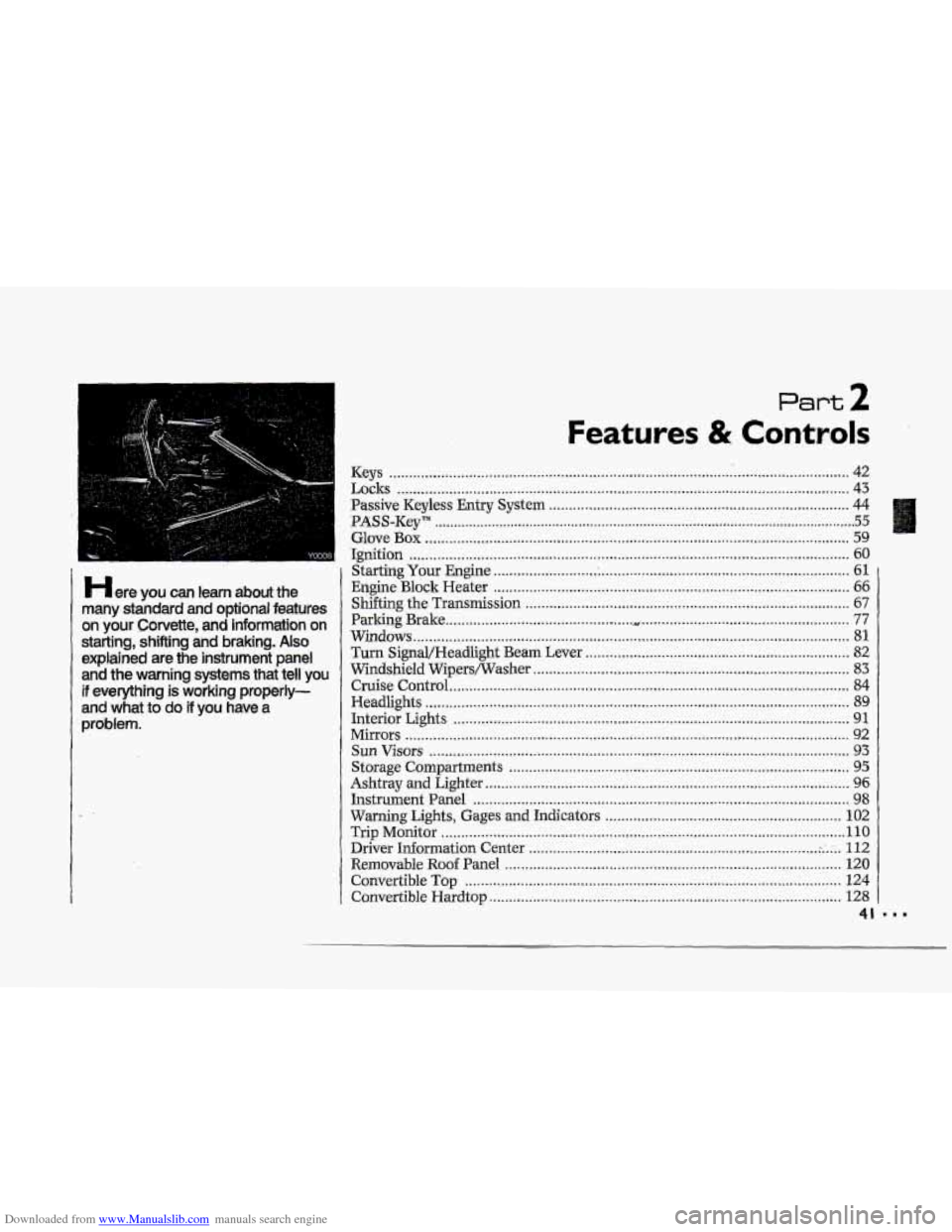
Downloaded from www.Manualslib.com manuals search engine !
....
+-
Here you can learn about the
many standard and optional features
on your Corvette. and information on
starting. shifting and braking . Also
explained are the instrument panel
and the warning systems that tell you
if everything is working properly-
and what to do if you have a
problem .
Part 2
Features & Controls
Keys ........................................................................\
........................................... 42
Locks ........................................................................\
......................................... 43
Passive Keyless Entry System ........................................................................\
... 44
Glove Box ........................................................................\
.................................. 59
Starting Your Engine ........................................................................\
.................. 61
Engine Block Heater ........................................................................\
................. 66
Shifting the Transmission ........................................................................\
......... 67
Parlring Brake ............................................... .................................................... 77
Turn SignaVHeadlight Beam Lever .................................................................. 82
Windshield Wipers~asher ........................................................................\
....... 83
Cruise Control ........................................................................\
............................ 84
PASS-Key'" ........................................................................\
....................................... 55
Ignition ........................................................................\
...................................... 60
Windows ........................................................................\
..................................... 81.
Headlights ........................................................................\
.................................. 89
Interior Lights ........................................................................\
........................... 91
Storage Compartments ........................................................................\
............. 95
Mirrors 92
Sun Visors ........................................................................\
................................. 93
Ashtray and Lighter ........................................................................\
................... 96
Instrument Panel ........................................................................\
...................... 98
Warning Lights, Gages and Indicators ........................................................... 1 02
........................................................................\
.......................................
Trip Monitor ........................................................................\
............................. 1 IO
Driver Information Center ........................................................................\
. .:. .... 112
Convertible Hardtop ........................................................................\
................ 128
Removable Roof Panel ........................................................................\
............ 120
Convertible Top ........................................................................\
...................... 124
41
Page 53 of 370
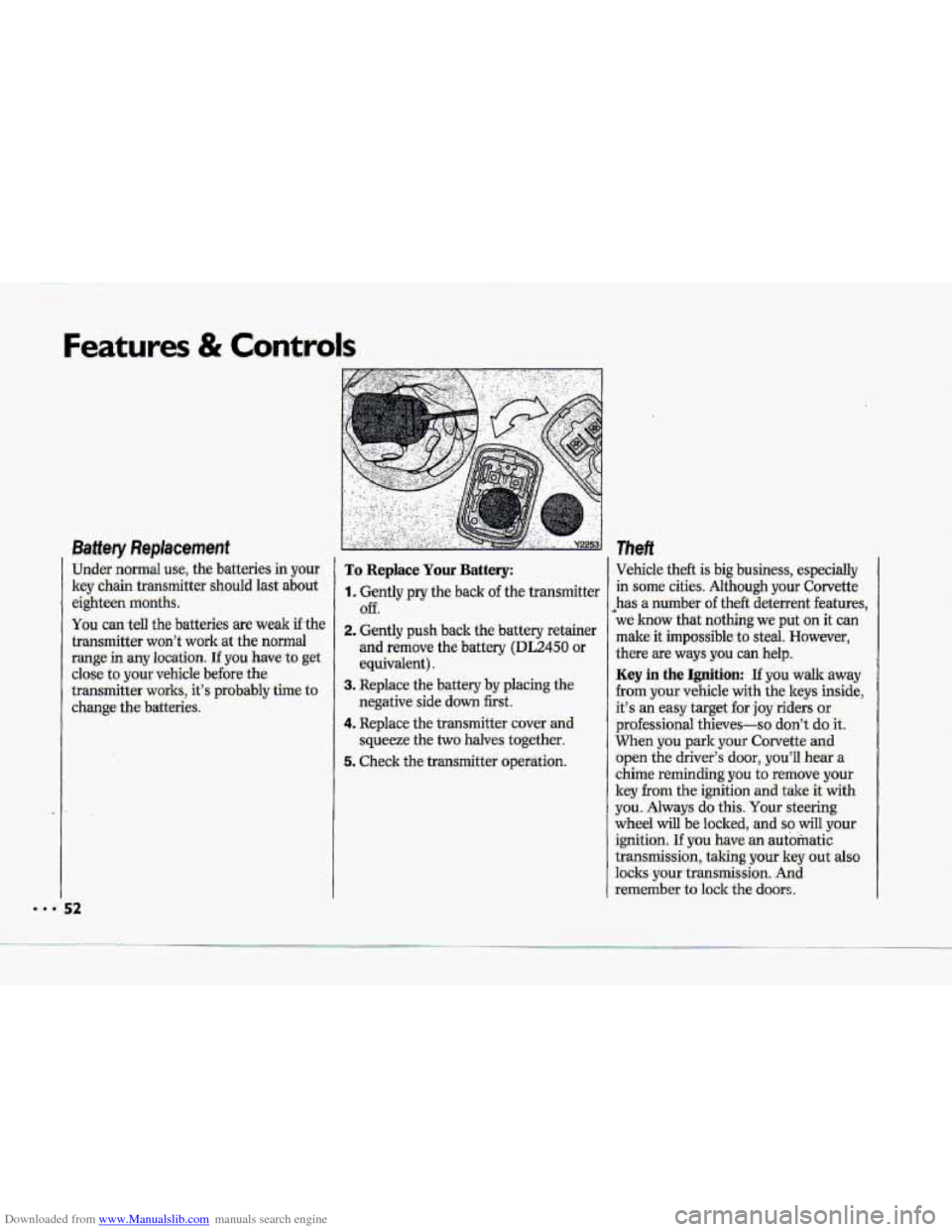
Downloaded from www.Manualslib.com manuals search engine -
Features & Contr ,Is
Baff ery Replacement
Under normal use., the batteries in your
key chain.tramnitter should last about
eighteen months.
You can tell the batteries are weak if the
transmitter won’t workat
the normal
range in any location. If you have to get
close to your vehicle before the
transmitter
works, it’s probably time to
change the batteries.
To Replace Yaw Battery:
1. Gently pry the back of the transmitter
Off.
2. Gently push back the batteryretainer
and remove the battery (DL2450 or
equivalent),
-3. Replace the battery by placing the
negative side
down first.
4. Replace the transmitter covmand
squeeze the
two halves together.
5. Check the transmitter operation.
Theft
Vehicle theft is big business, especially
in
some cities. Although yo.ur Corvette
$as a number
of theft deterrent features,
we how that nothi-ng we put on it can
make it impossible to steal. However,
there are ways you can help.
Key in the Ignition: If you walk awgy
from your vehicle with the keys inside,
it’-s ;an.easy target far joy riders or
professional thieves-so don’t do it.
When you park your Corvette and
open the driver’s door, you’ll heat a
chime reminding you to remove your
key from the ignition and take it with
you.
Always do this. Your steering
wheel will be locked, and so will yo.ur
ignition.
I€ you have-an autbmatic
transmission,,
taking your key out also
locks your transmission-. And
remiember to lock the doors.
Page 58 of 370
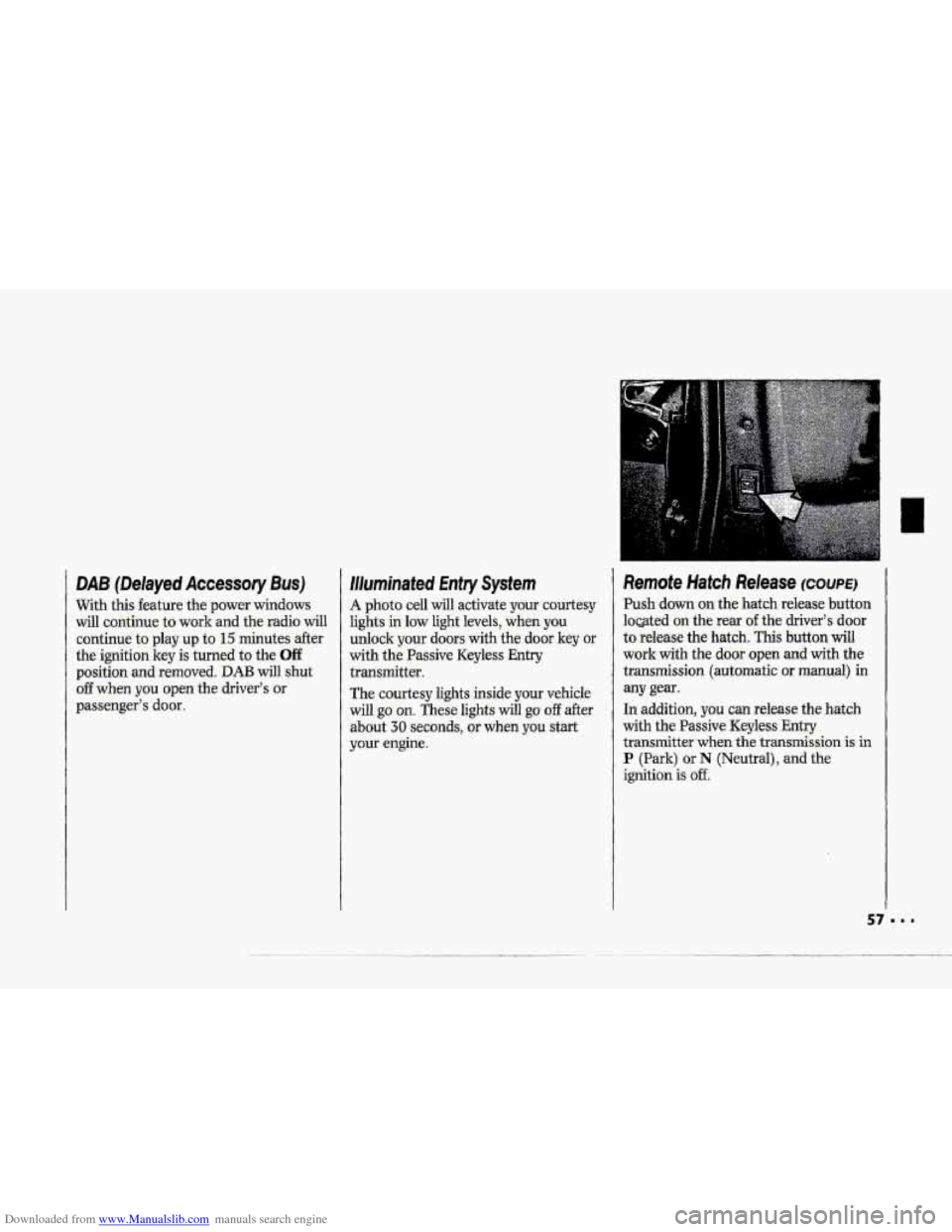
Downloaded from www.Manualslib.com manuals search engine DAB. (Delayed Accessory Bus)
With this feature the: power windows
will continue to work and the radio will
continue
to play .up,to 15 minutes after
the ignitiorikey is turned to the Off
position and: removed. DAB will shut
off when you open the ,driver’s or
passenger’sdoor.
illuminated Entry System
A photo cell will activate your :courtesy
lights in low light levels, when you
unlock your do-ors with the door key or
with the Pawive Keyless Entry
,transmitter.
The courtesy lights inside your vehicle
will
go on. These lights will go off after
about 30 seconds, or when you start
your engine.
Remote Hatch Release COUPE^
Push-down. on the hatch release button
loated
on the rear ofthe driver’s door,
to release the hatch. This button will
work with the dooi. open and with the
transmission (automatic
ar manual) in
any gear.
In addition, YQU can release the hatch
with the Passive Keyless
Entry
transmitter when the transmission is.. in
P (Park) or N (Neutral), and the
ignition
is off.
Page 59 of 370
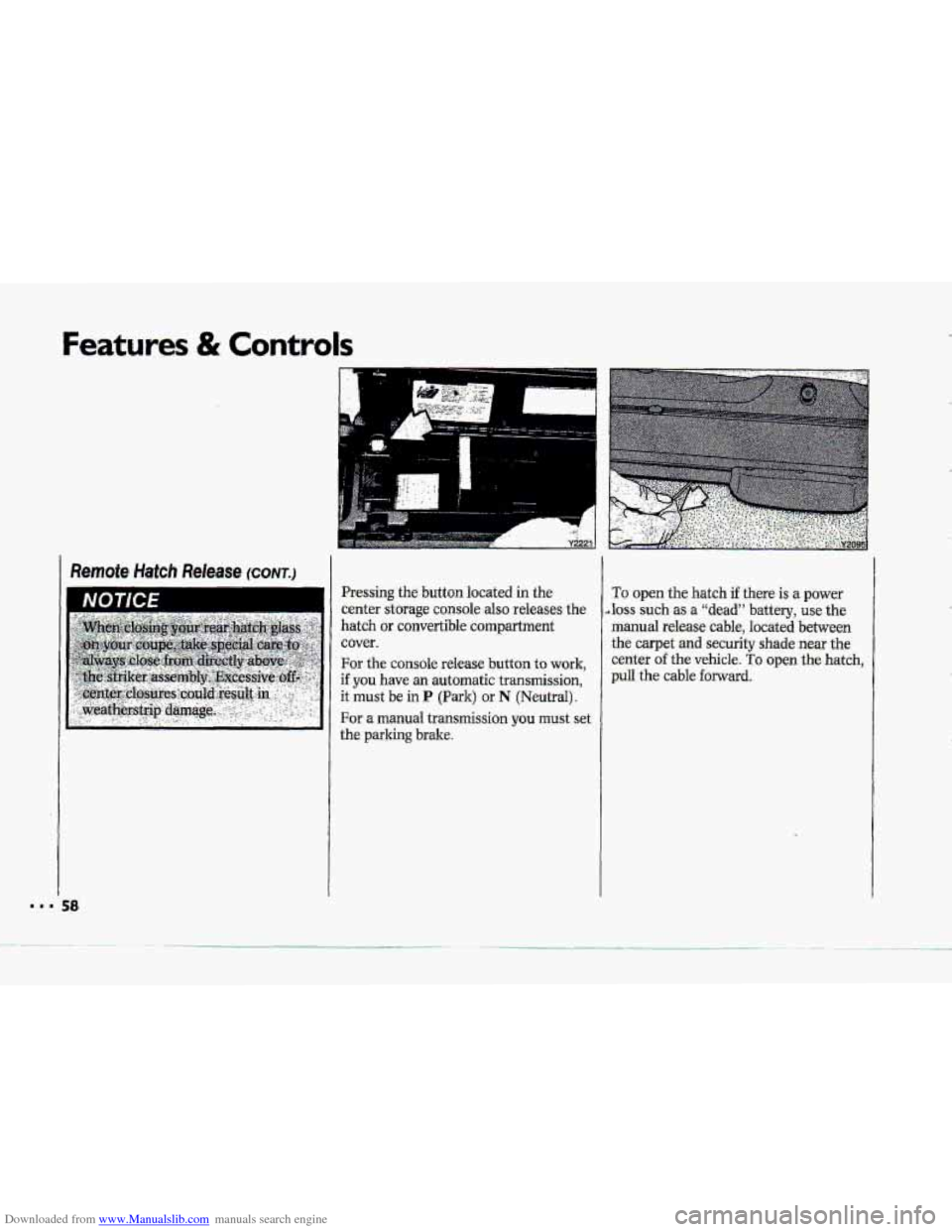
Downloaded from www.Manualslib.com manuals search engine Featurc ; & Controls
Remote Hatch Release (CONT.)
Pressing the button located in the
center
storage console also releases the
hatch
or qmvgdjble c;ompartment
cover.
For the console release button to work,
if you have an automatic transmission,
it must be in P (P.a-1~) or N (Neutral).
For a manual transmission you must set
the parking. brake.
To open the hatch if there is a power
.loss such as a "dead" battery, use the
manual release cable, located between
the carpet and security shade near .the
center of the vehicle. To open the hatch,
pull the cable forward.
Page 61 of 370
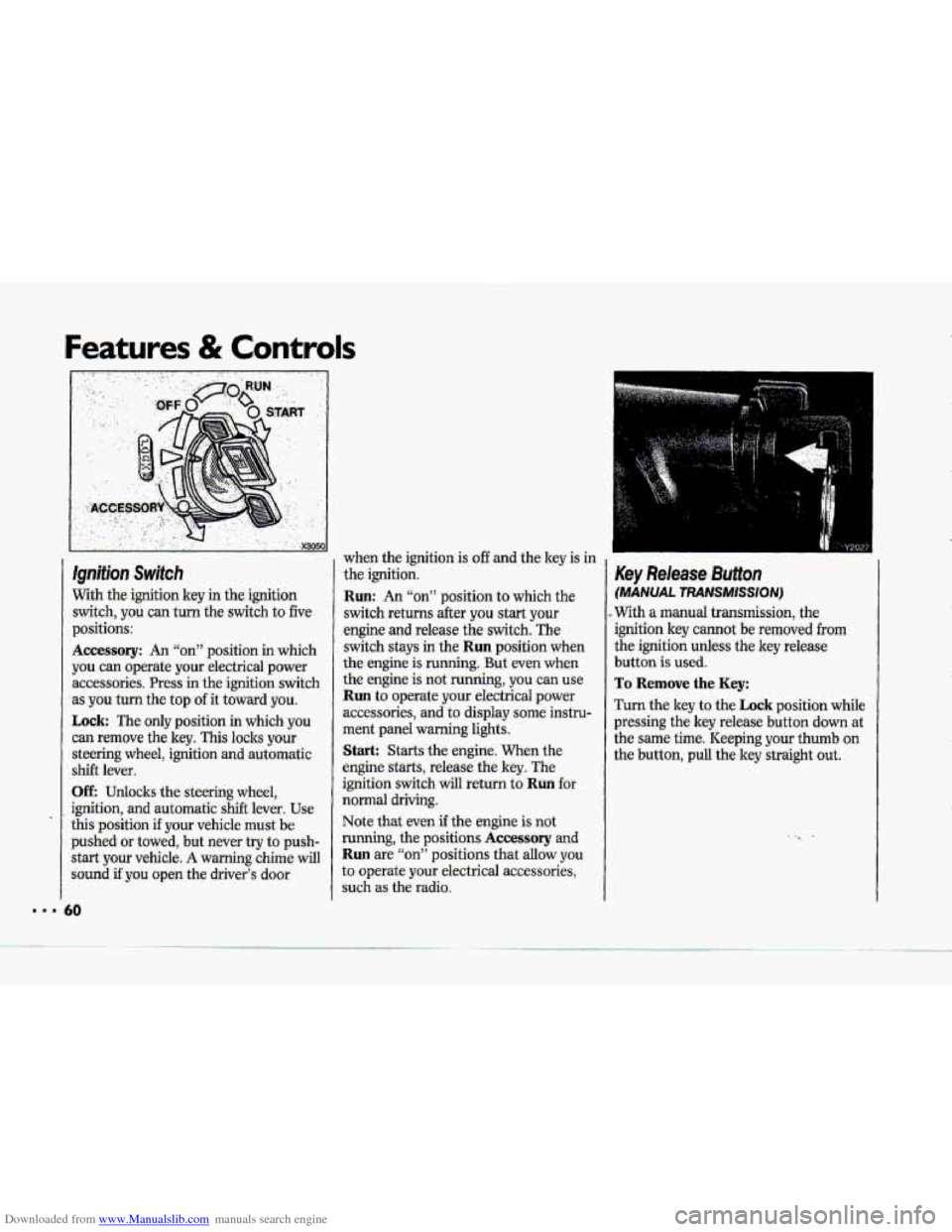
Downloaded from www.Manualslib.com manuals search engine Features & Controls
Ignition Switch
With the-ignition key in the ignition
switch, you can turn
the switch to five
p.ositions:
Accessory: An “on” position in which
you
can operate your .electrical power
accessories. Press in the-ignition .switch
as
you turn the top of it toward you.
Lock: The only position in which you
can remove the key. This locks your
steering wheel, ignition. and automatic
shift lever.
UE Udo:cks the steering wheel,
ignition, and automatic shift lever. Use
this pasition if your vehicle must be
pushed or towed, but never try to push-
start your vehicle-.
A warning chime will
sound if you open the driver’s door when
the ignition is
off and the key is in
the ignition.
Run: An “on” position to which the
switch returns after you start your
engine and release the switch. The
switch stays in
the Run position when
the engine is running. But -even when
the engine is-not running, you can use.
Run to operate your electrical power
accessories,
and to display some instru-
ment panel warning lights.
Start: Starts the engine, When the
engine starts, release the key. The
ignition switch will return to
Ruil fot
noma1 driving.
Note
that even if the engine is not
running, the positions
Accessory and
Run are “on” positions that allow y0.u
to operate your electrical accessories,
such
as the radio.
Key Release Button
(MANUAL TRANSMISSION)
..With a manual transmission, the
ignition key c-ot be removed from
the ignition unless the key release
button is used.
To Remove the Key:
Turn the key to the Lock position while
pressing the
key release buttoa down at
the same time. Keeping your thumb on
the button, pull the key straight out.
Page 62 of 370
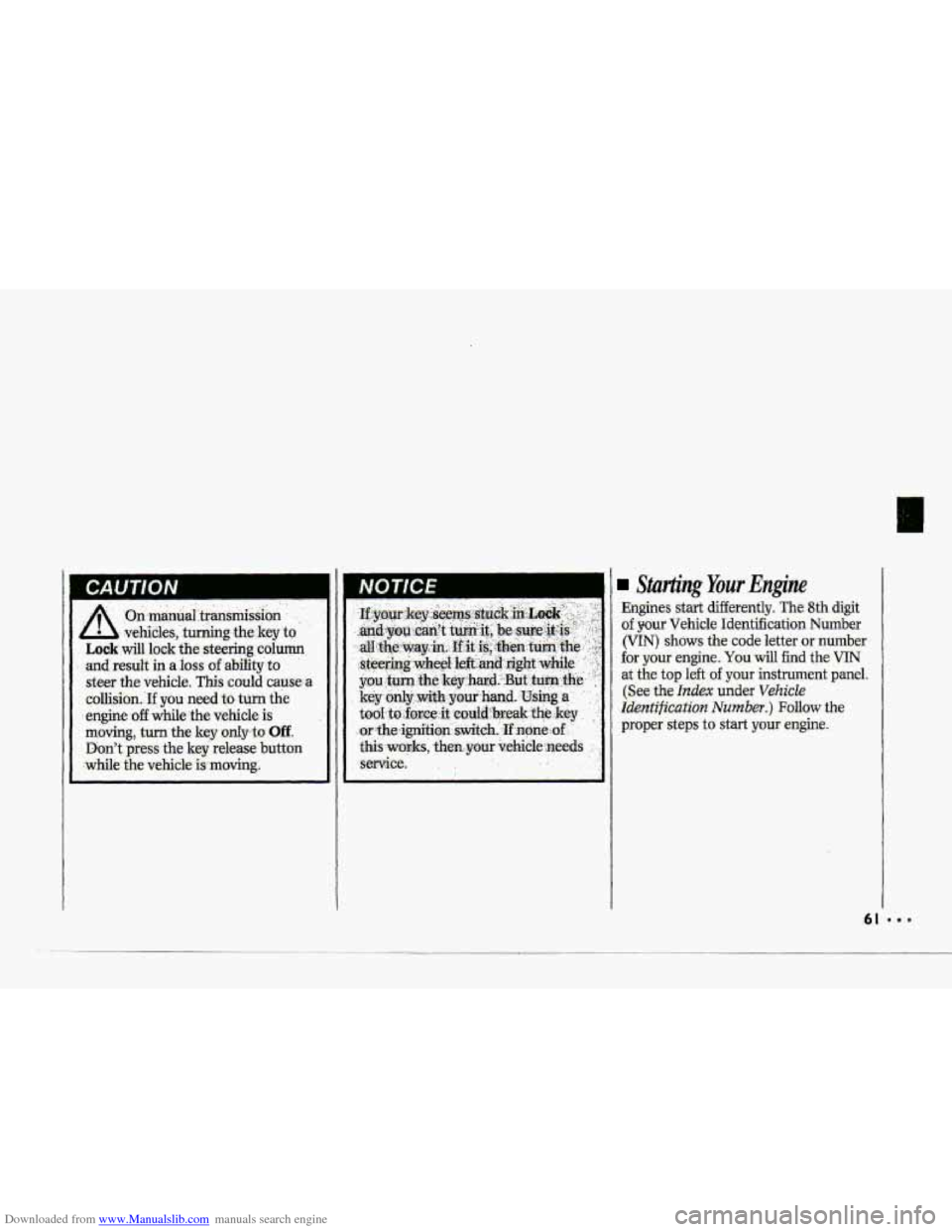
Downloaded from www.Manualslib.com manuals search engine on manuai , transmission
vehicles,' turning
the key to
Lock will lock the steering column
and result
in a ioss of ability to
steer the vehicle. This could cause a
collision..
If you need to turn the
engine off while 'the vehicle is
moving, turn the key only-to Off.
Don't press the key release button
while the vehicle
is moving.
Starting Your Engine
Engines start differently. The 8th digit
of your Vehicle Identification Number
(VIN) shows the code letter or number
for your engine. You will find the VIN
at the top left of your instrument panel.
(See the
Index under Vehicle
Identification Number.) Follow the
proDer steps to start
your engine.
1
61
Page 63 of 370
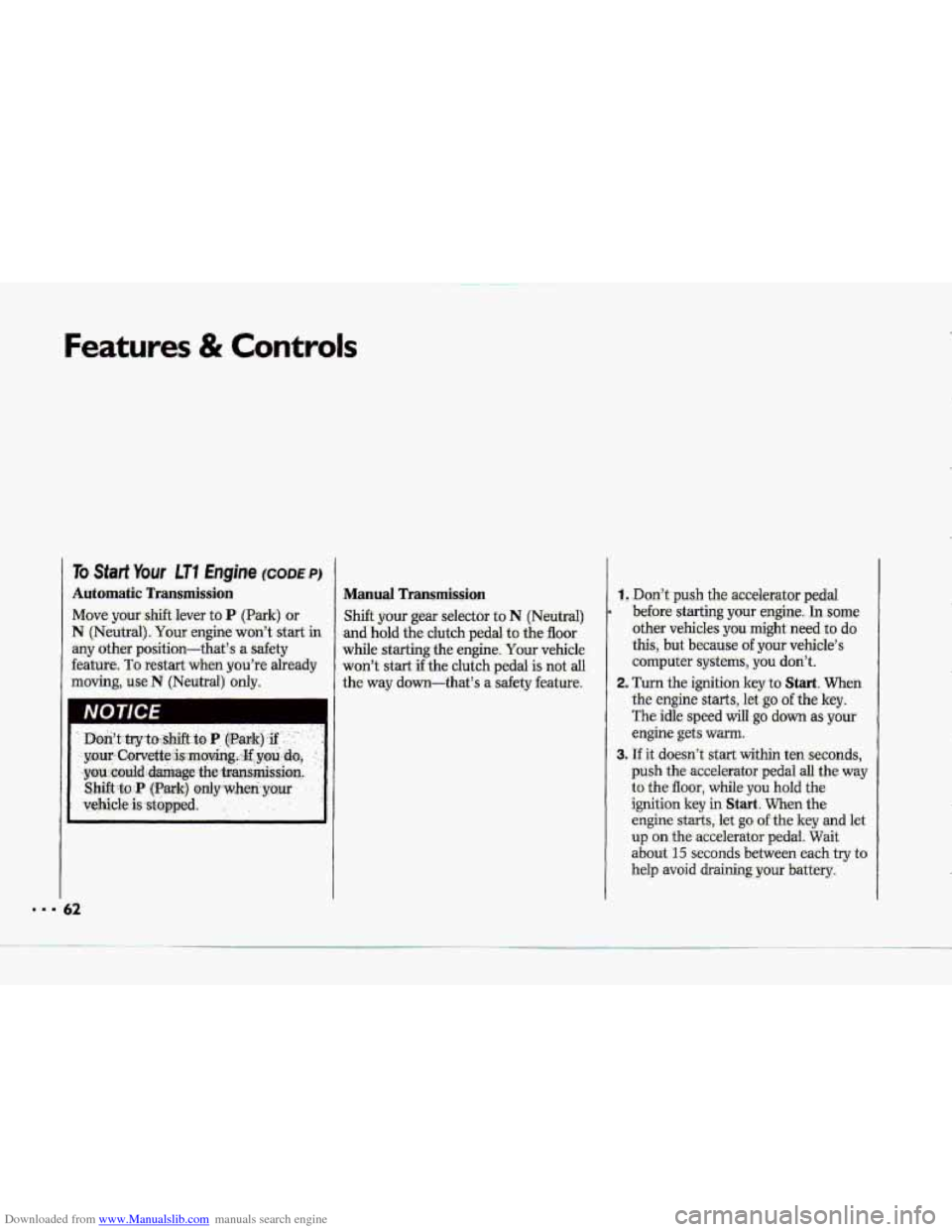
Downloaded from www.Manualslib.com manuals search engine Features & Controls
To Start Your fT7 Engine (CODEPI
Automatic Transmission
Move yaur,xhift.lever to P (Park) or
N (Neutral). Your engine won’t start in
any other position-that’-s -a sdety
feature. TO restart when you’re already
moving, use.N (Neutral) only.
i2
Manual Transmission
Shift your gear selector to N (Neutral)
md hold the clutch pedal tu the floor
while starting-the engine.
.Your vehi.cle
won’t start if the clutch pedal is not aIl
the way down-that’s a safety feature.
1, Don’t push the accelerator pedal
before
starting your engine. In s~me
other ve.hicles you might need to do
this, but because of your vehicle’s
Computer systems,
you don’t.
2. Turn the ignition key.ta Start. When
the engine starts,
let go of the key.
The idlespeed wiil go down as-your
engine
gets warm.
3. If it doesn’t start within ten-seconds,
push the-accelerator pedal all the way
to the;floor, while you hold the
ignition
key in Start. When the
engine starts, let go ofthe key and let
up on.the accelerator ped.4. Wait
abaut .15 seconds between each.try to
help -avoid draining your battery. --
Page 68 of 370
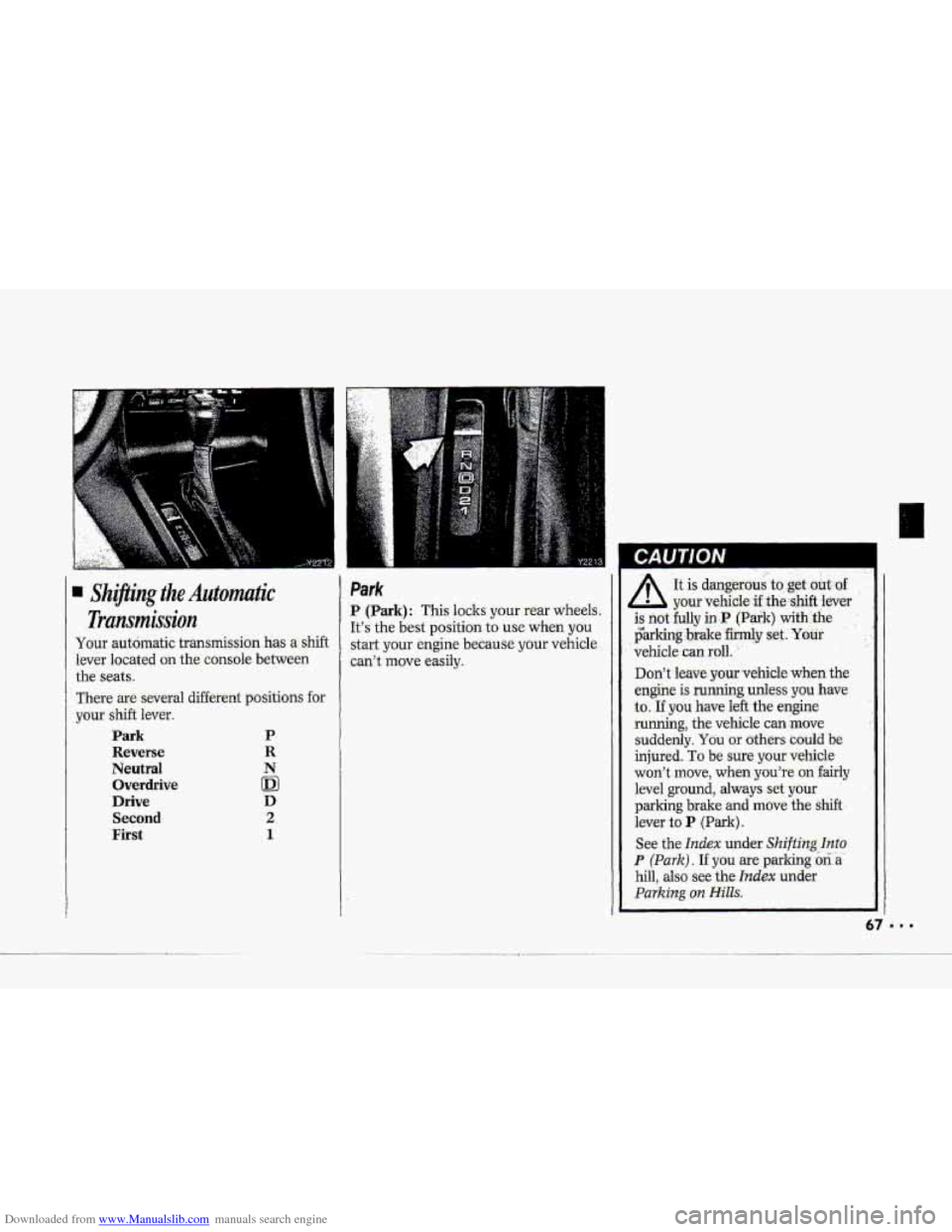
Downloaded from www.Manualslib.com manuals search engine 9 Shifting the Automatic
Transmission
Your automatic transmission has a shift
-lever located on the console- between
the seats.
There
sire several different positions for
your shift lever.
Park
Reverse
Neutral
Overdrive
Drive
Second
First
P -
D
D
2
1
Park
P (Park): This loclts your rear wheels.
It’s the
best position to use when you
start your engine because your vehicle
can’t move easily.
CAUTION I
It is dangerous to,:get oui:-af :
your ‘vehicle -3 th&hift lever
is not fully in P (Park) ,with the
p”arkinglbrdce~My set. your
vehicle :can roll. ’
Don’t leave your,vehicle when the
engine is running unless you have
to. If you have left the engine
running, the vehicle can -move
suddenly.
You or ,others could be
injured. To be sure your vehicle
won’t move, when you”re
on fairly
level ground, always set. your
parking brake and move the shift -
lever to P -(Park).
See the
Index under Shifting Into
hill, also see the Index under
Parking on Hills.
P (Park). If you are parking 0ri:a.
Page 69 of 370
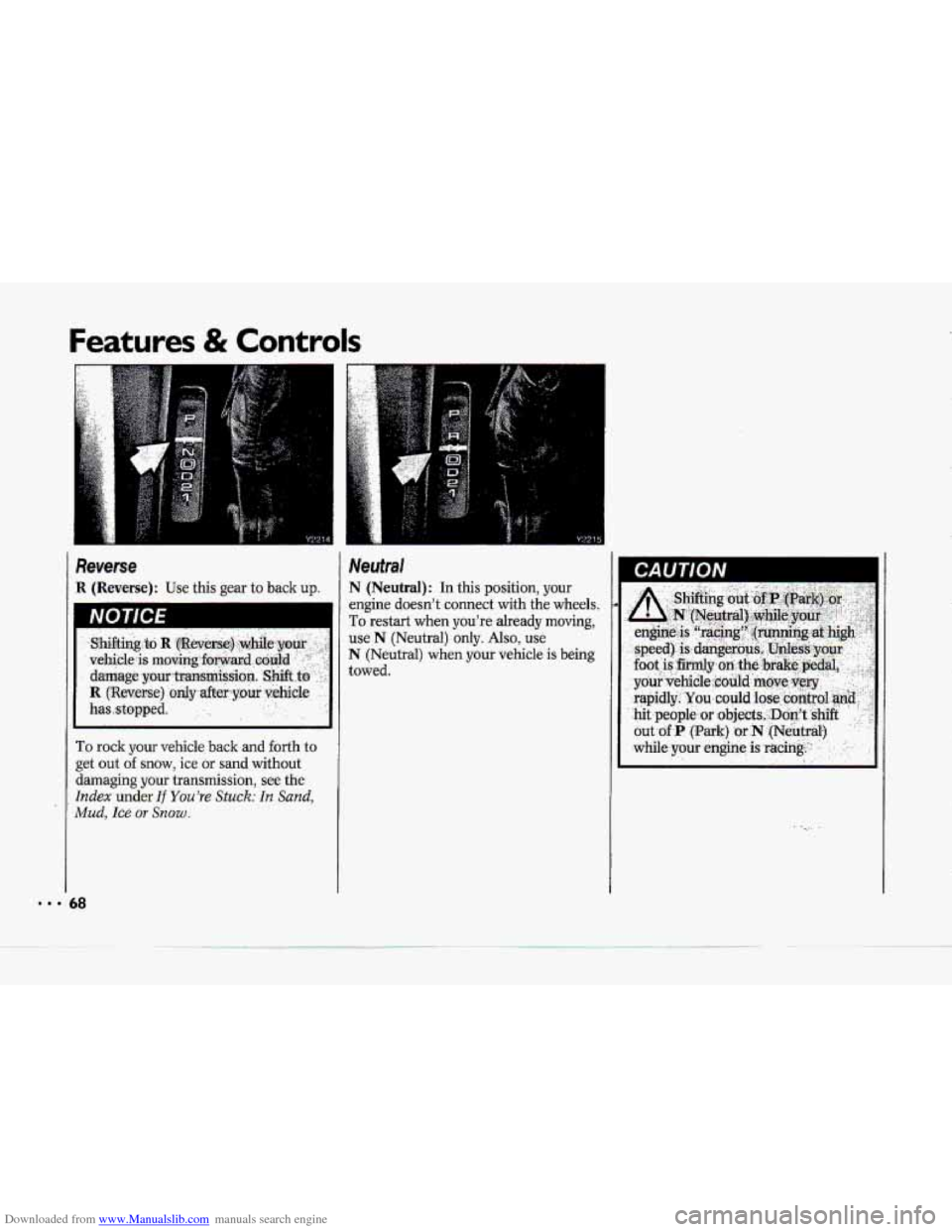
Downloaded from www.Manualslib.com manuals search engine Features & Controls
Reverse
R (Reverse): Use this gear to back up.
To rock your vehicle back and forth to
get out of snow, ice or sand without
damaging your transmission, see the
' Index under If You're Stuck: In Sand,
Mud, Ice OY Snow.
Neutral
N (Neutral): In this position, your
.engine doesn't connect with the wheels.
To restart when you're already moving,
use N (Neutral) only. Also, use
N (Neutral) when yourvehicle is being
towed.
CAUT/ON
68
Page 70 of 370
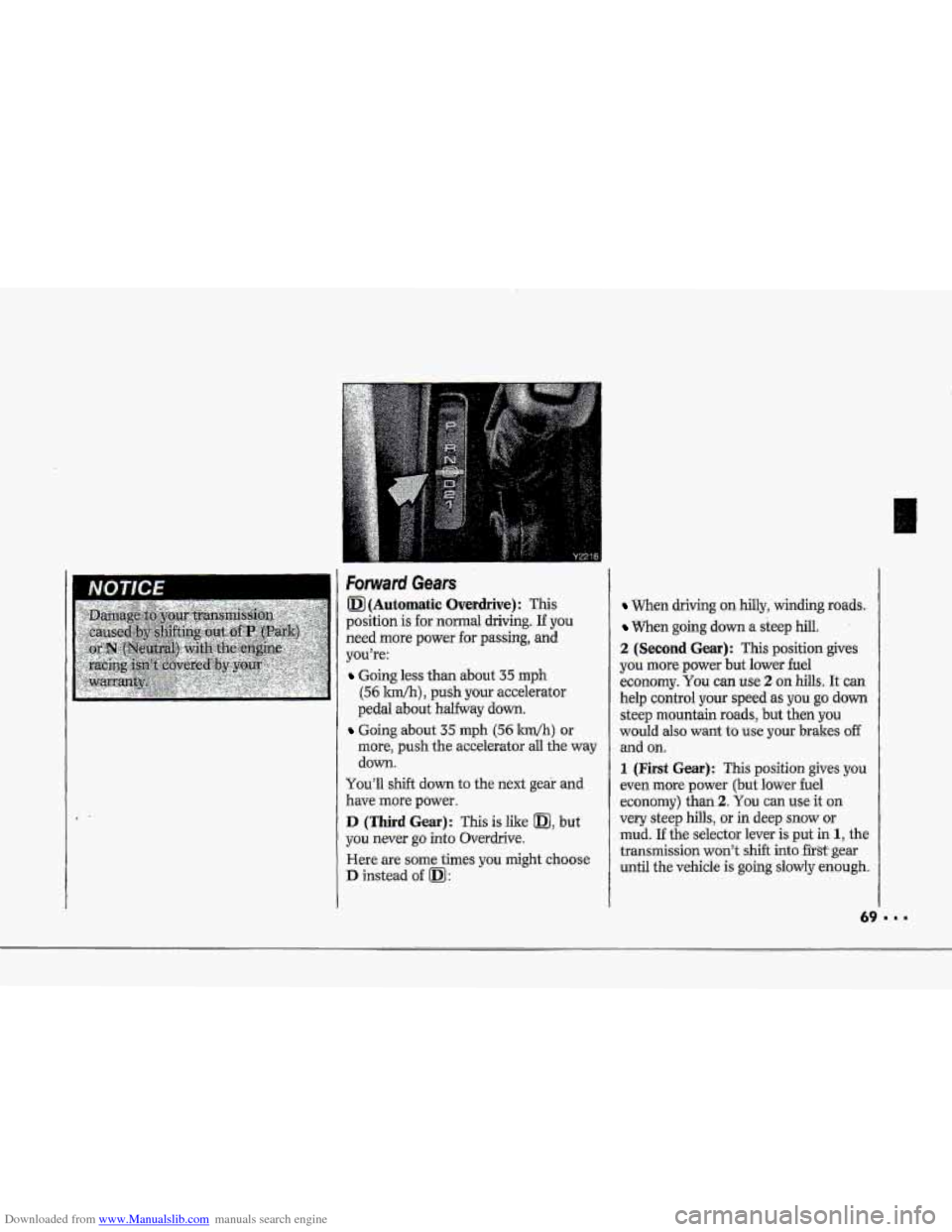
Downloaded from www.Manualslib.com manuals search engine Forward Gears I
0 (Automatic Overdrive): This
position is. for normal driving. If you
need more power for passing, and
you're:
Going less than about 35 mph
(56,lUn/h), push your accelerator
pedal
about halfway down.
Going about 35 mph (56 ldh) or
more, push the accelerator all .the way
down.
You'll shift down to the next geai and
have more power.
D (Third Gear): This is like m, but
you never go into Overdrive.
Here-are
some times you might choose
D instead of a:
When driving on hilly, winding roads.
When going down a steep hill.
2 (Second Gear): This position gives
you more. power but lower -fuel
economy.
You can use 2 on hills. It can
help control your speed as yuu go down
steep mountain roads, but then you
would also want to use your brakes off
and on..
1 (First Gear): This position gives you
even more power (but lower fuel
economy)
than 2. You can use it on
very steep hills, 01 in deep snow or
mud. If
the selector lever is put in 1, the
transmission won't shift into first- gear
until the vehicle is going slowly enough.